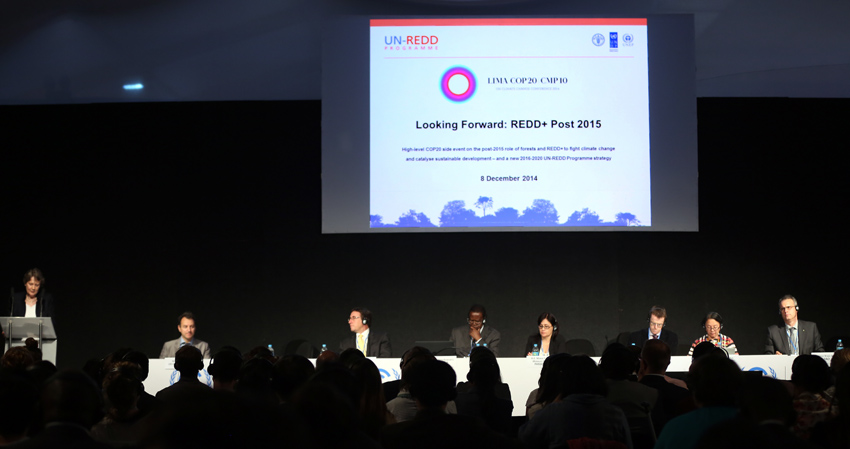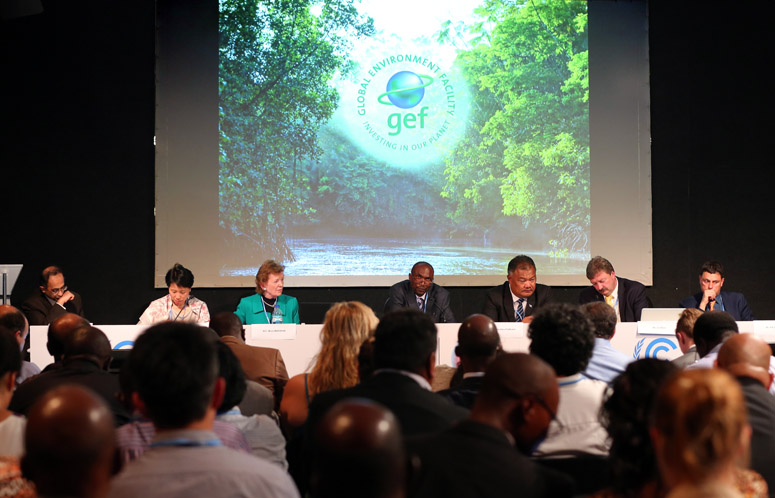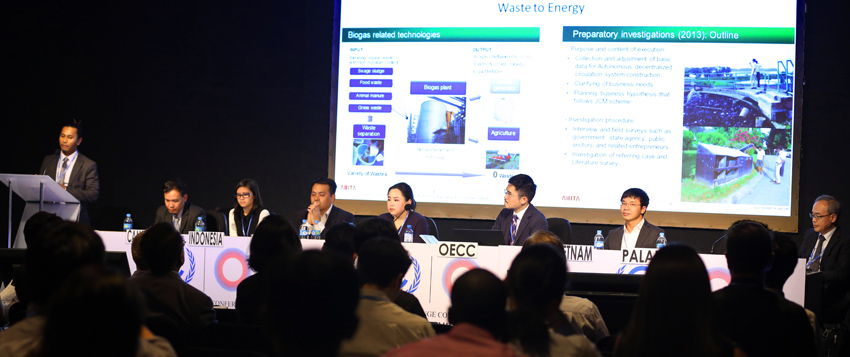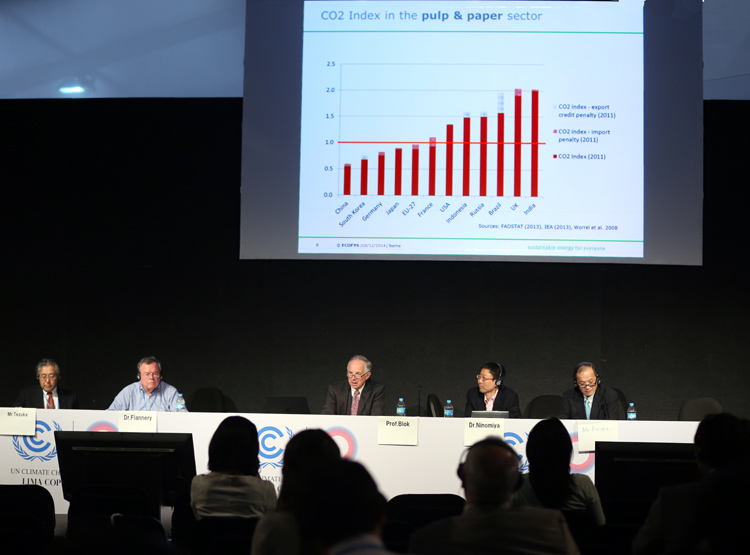|
| |
|
| |
 |
 |
 |
 |
This high-level dialogue, moderated by Helen Clark, Administrator for the UN Development Programme (UNDP) and Chair of the UN Development Group, was convened to explore a post-2015 vision for REDD+ as a catalyst for sustainable development and the 2016-2020 role of the UN-REDD Programme.
Introducing the session, Mario Boccucci, Head, UN-REDD Programme Secretariat, welcomed the high levels of “technical understanding” and political support at COP 20, noting that delivering on implementation poses both the greatest challenge as well as an opportunity for realizing the promise of REDD+ in the post-2015 development framework.
In her opening remarks, Clark said that as the largest terrestrial store of carbon, forests must be at the center of post-2015 sustainable development efforts. Noting that 13 million hectares of forest are cleared annually, accounting for around 20% of greenhouse gas (GHG) emissions, Clark highlighted UN-REDD’s efforts to support readiness activities in 56 countries to implement the Warsaw Framework for REDD+ and welcomed additional commitments at the UN Secretary General’s Climate Summit in September 2014.
Achim Steiner, UNEP Executive Director, offered some reflections on the historical evolution of REDD+, noting that “we should take heart” that it has taken less than 10 years to ensure that the framework is at the mainstream of climate negotiations. He highlighted Indonesia’s REDD+ programme as an example of a green economy pathway in which the private sector has a “clear and legitimate” role to play.
Eduardo Rojas-Briales, Assistant Director-General for Forestry, UN Food and Agriculture Organization, said that REDD+ programmes should be framed within the context of how natural resource management can contribute to adequate nutrition and deliver a vast range of development benefits, especially for local people.
He outlined ways in which the three UN-REDD partner agencies are supporting actions at country and global levels and helping to “fit the pieces of the REDD puzzle together.” He further underscored the need to focus on both mitigation and adaptation measures, especially in drylands.
Per Pharo, Director, Norway’s International Climate and Forest Initiative (NICFI), noted that the evidence base for the claim that REDD+ offers a win-win solution for a vibrant “new climate economy” has been strengthened over the past decade, but determined action is still needed. He noted the role of the Forest Carbon Partnership in mobilizing financing for developing countries and called on the private sector to expand current best practices to ensure deforestation-free products in all supply chains.
Ephraim Kamuntu, Minister of Water and Environment, Uganda, said his country considers forestry as the driver of its economic transformation. He noted 85% of Ugandans derive their livelihoods from forestry and forest products, which calls for concerted efforts to find alternative energy sources.
Maria Cristina Morales Palarea, Minister of Environment, Paraguay, welcomed the REDD+ initiative for boosting the country’s institutional capacity to control illegal deforestation and highlighted ongoing efforts to restore and expand forest cover, especially in indigenous areas.
Vicky Tauli-Corpuz, UN Special Rapporteur on the Rights of Indigenous Peoples, cited a study in Brazil that showed deforestation rates in areas under indigenous control are much lower than the national average. She stressed the need to safeguard indigenous peoples’ human rights, lamenting that indigenous leaders continue to be killed for asserting their rights to forests.
Country representatives then shared their experiences. In relation to his country’s forest management, Indonesia noted that the country has passed through a “cut-and-run” phase, and is now in the “cut-and-plant” phase, but needs to shift to the “maintain-and-restore” phase in order to improve productivity and restore degraded lands, calling for the post-2015 agenda to focus on “mitidaption”- a combination of adaptation and mitigation. Ecuador highlighted the country’s efforts towards REDD-readiness including creating a carbon map and establishing a safeguard information system. Zambia stressed the need for support in the implementation phase, noting the strong linkages between REDD+, sustainable forests management and sustainable development. Tunisia shared the country’s one-year REDD+ experience, noting the programme is essential to addressing climate change. The World Bank described the Forest Carbon Partnership, and reiterated the Bank’s commitment to supporting countries implementing REDD+.
In the ensuing discussion, participants highlighted, inter alia: the complexities of the REDD+ funding processes which are not user-friendly; the need to focus on forest landscape restoration before the REDD+ resources are made available; and efforts to strengthen forest governance and the rule of law in the establishment of safeguard information systems. |
|
 |
 |
 |
 |
|
| |
|
| |
 |
 |
 |
 |
 |
L-R: Helen Clark, UNDP Administrator; Mario Boccucci, Head, UN-REDD Programme Secretariat; Achim Steiner, UNEP Executive Director; Ephraim Kamuntu, Minister of Water and Environment, Uganda; Maria Cristina Morales Palarea, Minister of Environment, Paraguay; Per Pharo, Director, Norway’s International Climate and Forest Initiative (NICFI); Vicky Tauli-Corpuz, UN Special Rapporteur on the Rights of Indigenous Peoples; and Eduardo Rojas-Briales, Assistant Director-General for Forestry, FAO
|
|
 |
 |
 |
 |
|
| |
|
| |
|
| |
|
| |
 |
 |
 |
 |
Moderated by Nouf Aburas, Ministry of Petroleum and Mineral Resources, Saudi Arabia, panelists addressed energy efficiency projects and programmes in Saudi Arabia and Qatar. Aburas highlighted economic diversification efforts in the GCC, noting the importance of shifting to more energy efficient standards in the region to promote diversification.
Abdullah Al Sarhan, Ministry of Petroleum and Mineral Resources, Saudi Arabia, presented on energy efficiency in the country, highlighting demand-side considerations. Noting the increase in energy consumption, he highlighted government programmes and projects that promote awareness, as well as government involvement in promoting energy efficiency in private projects. He drew attention to the Saudi Energy Efficiency Center, responsible for the demand-side management of energy projects, further highlighting the work of the Saudi Energy Efficiency Programme in the transportation, building and industry sectors. Al Sarhan noted the guiding principles of the programme include: a focus on demand side management; a programme design which does not include price reform; a design based on end-user impact; and initiatives based on consensus with the government.
Baker Fallatah, SABIC, presented the company’s sustainability efforts, saying it is one of the world’s most diversified companies with over 10000 patent filings. He stressed, inter alia: sustainability as a key SABIC strategy, highlighting the creation of sustainability teams; standardized reporting methodologies; short- and long-term incentives for sustainability performance; awareness-raising efforts; and continuous experience-sharing with external partners. He outlined the aims of the sustainability programme as creating economic value, protecting natural capital, investing in people and engaging the community. He then presented current results of key performance indicators, including a reduction of the company’s green house gas emissions by 2%; and a 5% increase in energy efficiency.
Abdallah Al Khulaifi, KAHRAMAA, Qatar, noted the electricity and water utility’s efforts to promote energy efficiency, including labeling for air conditioners, and a lamp phase-out programme, which will contribute to CO2 reduction. He also highlighted power-sector lighting programmes, and a LED street lighting project expected to increase energy efficiency countrywide. Al Khulaifi stressed the importance of law enforcement and community awareness programmes in addressing energy and water efficiency, and described a KAHRAMAA awareness park and a conservation building competition as awareness raising activities. He also outlined a demand-side water management project, as well as the company’s conservation regulations including for lighting control systems and high efficiency motors.
In the discussion, participants considered the benefits of energy efficiency programmes; building codes and other legislation in Qatar to promote energy efficiency; the need for sustainability reports to comply with international standards; and energy efficiency targets for Saudi Arabia. |
|
 |
 |
 |
 |
|
| |
|
| |
|
| |
|
| |
|
| |
 |
 |
 |
 |
This event, moderated by Barbara Buchner, Climate Policy Initiative, constituted the official launch of the Geothermal Development Facility (GDF) as a first multi-donor climate initiative to promote geothermal resources as a renewable energy source. Buchner opened a high-level panel discussion, lamenting the slow rate of geothermal energy deployment and stating that introducing geothermal energy into the energy mix could be a “game changer.”
Edwin Quintanilla, Vice-Minister for Energy, Peru, noted the potential of geothermal energy to change the dynamics of global energy demand, particularly for countries in a rapid growth phase such as Peru. He announced the country’s intention to transform toward having 75% of their energy mix consist of renewables over the next four years, underscoring the national energy plan of doubling hydro-electric power generation, doubling gas exploration and achieving energy access for the entire population.
On reducing carbon emissions and finding a solution to reduce environmental impact, Gerd Müller, BMZ, Germany, said the energy sector poses the greatest challenges. With an expected 40% increase of energy demand in the near future, he emphasized the importance of developing new energy sources, separating growth from energy demand, and adapting to regional conditions.
Miguel Arias Cañete, EU Commission, stressed the EU’s intention to invest in clean and affordable renewable energy technologies, including geothermal energy development. He stated that the GDF would provide significant impetus to developing capacity, technological expertise, and infrastructure in Latin America.
The GDF was then officially launched with a cutting of a ribbon by the participating donors. This was followed by a brief presentation by Jens Wirth, KfW, on the benefits of geothermal energy, including: as a proven clean technology; as a stable source of base-load power; producing energy with very low CO2 emissions; and affordable electricity.
Stephan Opitz, KfW, noted the concerted effort from all partners toward launching the initiative. He said this resulted in an innovative concept with instruments that will prove to be effective and efficient, and will leverage substantial funding for investing in the facilities.
Hanz Schulz, Inter-American Development Bank (IADB), lamented that although geothermal energy development has huge potential, it has been held back due to the risks involved. He compared it to mining, stating that there is even less certainty of “hitting the resource right.” Urging the need for complementarity of investment from the private sector, he noted IADB’s engagement with the regulatory level through informing of the risks involved and capacity building.
Jonathan Taylor, European Investment Bank (EIB), said the Bank’s principal operational priorities include adaptation and mitigation activities, recalling their involvement in geothermal energy development since the previous century. He noted the Bank’s initial pledge of US$250 million to attract involvement from the public and private sector.
Laurence Breton-Moyet, African Development Bank (AfDB), said that while world leaders are negotiating an ambitious agreement “next door,” the private sector is collaborating to produce concrete solutions, one of which is demonstrated through the launch of the GDF. She pledged the Bank’s full support for the establishment and further development of the GDF.
Vera Scholz, German Agency for International Cooperation (GIZ), announced designating EU€6 million for technical support of the GDF over the next four years. She identified other areas of support, including strengthening the legal and regulatory framework on geothermal energy development, and administrative and procedural aspects, such as clearance processes, while improving the private and public sector engagement.
Hamilton Moss de Souza, CAF Development Bank of Latin America, underscored that the launch of the GDF is a “historical moment in time,” mainly in having so many institutions participating in an endeavor that could contribute significantly toward increasing renewable energy output.
Malcolm Cosgrove-Davies, World Bank Group, outlined the resource risks as key challenges in geothermal development, in addition to normal market risks, and the longer time span when compared to other renewable energy resources. He emphasized that once established, it will prove to be one of the least costly, most reliable and cleanest sources of renewable energy.
Toshitaka Takeuchi, Japan International Cooperation Agency (JICA), described the agency’s support for the development of geothermal technologies in the Latin American region as a major component to the renewable energy mix. He said one way to reduce the risk is to collaborate with partnering institutions, and pledged support for developing a policy framework, and building technological capacity.
Manuel Torres, Central American Bank for Economic Integration (CABEI), noted that the fund will allow for acceleration of geothermal energy establishment through incentives and new mechanisms, and stressed the importance of collaborating with other institutions.
Mafalda Duarte, Climate Investment Fund (CIF), emphasized the need to promote geothermal energy as a viable renewable energy resource, reminding it will be a stable-based installation with low-maintenance costs. On geothermal developments elsewhere in the world, including initial large-scale initiatives in Armenia, Kenya and Tanzania, she highlighted the Kenyan example of a private-public partnership which introduced a new paradigm on effectively mobilizing private and public investment.
Aage Jørgensen, Nordic Development Fund (NDF), reiterated the Nordic countries’ full support for the development of geothermal energy resources, particularly towards capacity building, since it represents fairly new technological expertise. He noted a training initaitve in Latin America, in collaboration with IADB, through which over 50 engineers had already been qualified in the field of geothermal energy.
|
|
 |
 |
 |
 |
|
| |
|
| |
| |
|
| |
|
| |
 |
 |
 |
 |
 |
L-R: Anand Patwardhan, GEF Scientific and Technical Advisory Panel; Naoko Ishii, CEO and Chairperson, the GEF; Mary Robinson, Mary Robinson Foundation - Climate Justice, Former President of Ireland; Pa Ousman Jarju, Minister of Environment, Climate Change, Water Resources, Parks and Wildlife, the Gambia; Taukelino Finikaso, Minister of Environment, Foreign Affairs, Labour and Trade, Tuvalu; Jozef Buys, Ministry of Foreign Affairs, Belgium; and Nik Sekhran, Director for Sustainable Development, UNDP
|
|
 |
 |
 |
 |
|
| |
|
| |
 |
 |
 |
 |
This side event, moderated by Anand Patwardhan, GEF Scientific and Technical Advisory Panel, discussed adaptation experiences from the Gambia and Tuvalu and addressed questions regarding: key successes and challenges from the implementation of projects; the main challenges in sustaining support to adaptation; and key challenges ahead for financial mechanisms and adaptation funds.
Naoko Ishii, CEO and Chairperson, the GEF, addressed the main reasons for hosting this side event, namely to: underscore the importance of adaptation activities on the ground; take stock of current achievements and identify ways to integrate adaptation in broader development processes. Ishii noted 300 adaptation projects in 128 developing countries, financed by GEF through the Least Developed Countries Fund (LDCF), the Special Climate Change Fund (SCCF) and the Strategic Priority on Adaptation.
Drawing from the Gambian experience, Pa Ousman Jarju, Minister of Environment, Climate Change, Water Resources, Parks and Wildlife, the Gambia, underlined main challenges, including level of funding and human capital, as well as successes in increasing awareness and enhancing capacity. He highlighted, inter alia: the need to mainstream adaptation in the development process; co-benefits from infrastructure; and the way forward towards replenishing the LDCF to cover the funding gap for adaptation projects.
Taukelina Finikaso, Minister of Environment, Foreign Affairs, Labour and Trade, Tuvalu, noted that for Small Island Developing States (SIDS), adaptation is a critical component of sustainable development. He stressed the need to: reform the modus operandi of the LDCF and the SCCF to allow for direct access of funds; and remove the co-financing condition.
Mary Robinson, Mary Robinson Foundation - Climate Justice, and Former President of Ireland, stressed that adaptation is about people and the impact of climate change on their livelihoods. She noted that according to UNEP’s adaptation gap report, the cost of adapting may be significantly higher than estimated before and addressed the human rights dimension, saying that climate finance works best with local communities, engaging citizens and maximizing sustainability. Robinson also highlighted the gender dimension, noting the importance of women’s empowerment.
Noting that considerable time was needed to balance mitigation and adaptation activities, Jozef Buys, Ministry of Foreign Affairs, Belgium, underscored GEF’s work in reducing vulnerability and strengthening institutional and technical capacities. He highlighted that the finance panorama is becoming increasingly complex with many different actors involved, and underscored the need to rationalize the financial mechanism and continue to support current projects.
Providing closing remarks, Nik Sekhran, Director for Sustainable Development, UNDP, noted that the GEF offers a package of investments and services, “joining the dots” between various environmental stressors. He underscored, inter alia, the need to: ensure that adaptation is codified in the developmental planning; change the development paradigm to incorporate climate change; strengthen national institutions and target capacity building; empower communities to identify solutions and innovations; and add innovative market sources to public resources currently utilized in adaptation efforts.
In the ensuing discussion, participants addressed, among others: ways to facilitate access to finance; co-financing requirements; evaluation of adaptation options; and the implementation of adaptation platforms, such as Canada’s, to other countries. |
|
 |
 |
 |
 |
|
| |
|
| |
|
| |
|
| |
 |
 |
 |
 |
 |
L-R: Xavier Matsutaro, the Office of Environmental Response and Coordination, Palau; Sum Thy, Ministry of Environment, Cambodia; Ratu Keni Atika, Joint Crediting Mechanism (JCM) Secretariat, Indonesia; Syamphone Sengchandala, Ministry of Natural Resources and the Environment, Lao PDR; Saruul Dolgorsuren, Ministry of Environment and Green Development, Mongolia; Makoto Kato, General Manager, OECC; Le Ngoc Tuan, Ministry of Natural Resources and Environment, Viet Nam; and Yuji Kimura, Executive Director, GEC
|
|
 |
 |
 |
 |
|
| |
|
| |
 |
 |
 |
 |
This side event, moderated by Jiro Ogahara, OECC, addressed the JCM, under operation among Japan and 12 partner countries, which aims to facilitate the diffusion of leading low carbon technologies, products, systems, services and infrastructure, as well as the implementation of mitigation actions, and contribute to sustainable development of developing countries.
Yuzi Mizuno, Ministry of the Environment, Japan, introduced the event and the JCM, addressing current efforts and activities.
Providing an overview of policies towards low carbon development in Cambodia, Sum Thy, Ministry of Environment, Cambodia, noted that next steps involve collaboration with Japanese partners to identify JCM projects, as well as approving the JCM rule and methodology.
Ratu Keni Atika, JCM Secretariat, Indonesia, said that 12 projects on energy efficiency and renewable energy are in the pipeline in Indonesia, and focused on sustainable development criteria as part of JCM, noting, inter alia the need to: develop indicators to evaluate achievement in JCM; ensure every JCM project will deliver co-benefits for the country; and fulfill global standards for appropriate climate change mitigation action.
Considering the status quo of JCM implementation in Lao PDR, Syamphone Sengchandala, Ministry of Natural Resources and the Environment, Lao PDR, underscored, among others: capacity-building cooperation programmes and feasibility studies under the JCM; that experience gained will contribute to low carbon and sustainable development in his country; and networking and matchmaking of private companies from Lao PDR and Japan as the most important cooperation feature.
Providing an overview of climate change mitigation policy in Mongolia, Saruul Dolgorsuren, Ministry of Environment and Green Development, Mongolia, underscored the main challenges related to JCM implementation, namely technical, financial and institutional barriers. She stressed that effective collaboration between Japan and Mongolia will be the catalyst for the JDM’s development.
Xavier Matsutaro, the Office of Environmental Response and Coordination, Palau, noted that the JCM is vital in supporting the country’s national goal towards low-carbon development by providing low-carbon technology. He underscored co-benefits for Palau and Japan, noting that ideas under exploration include ways for the broader public to benefit directly from JCM activities.
Le Ngoc Tuan, Ministry of Natural Resources and Environment, Viet Nam, underlined that JCM projects will, inter alia: contribute to effective responses to climate change; enhance competitiveness; and promote participation of private sector and communities.
Makoto Kato, General Manager, OECC, addressed various JCM projects in different countries, noting that the process includes: studies on applying low-carbon technologies in developing countries; assessment of potential by low-carbon technology experts; match making of private-private business in Japan and host countries; and organization of workshops for mutual learning.
Yuji Kimura, Executive Director, GEC, focused on the JCM study and financing programmes and their relationship. He described approved methodologies and registered projects under the JCM, and provided examples of the JCM model project.
During discussions, participants addressed, among others: the existence of government funded projects that are co-subsidized by the JCM; the assessment of proposed methodologies; the extent to which national regulations and standards are integrated in the methodologies; and potential markets for JCM credits.
|
|
 |
 |
 |
 |
|
| |
|
| |
|
| |
 |
 |
 |
 |
 |
L-R: Hiroyuki Tezuka, Chairman, Global Environment Strategy Working Group, Committee on Environment and Safety, Keidanren; Brian Flannery, Resources for the Future, US; Kornelis Blok, Ecofys; Yasushi Ninomiya, The Institute of Energy Economics, Japan (IEEJ); and Jun Arima, Director-General, London Office, Japan External Trade Organization
|
|
 |
 |
 |
 |
|
| |
|
| |
 |
 |
 |
 |
This side-event, moderated by Takahiko Tagami, The Institute of Energy Economics, Japan (IEEJ), discussed the latest research findings on sectoral energy efficiency and GHG-intensity indicators, as well as measures that world business leaders can take to improve energy efficiency and reduce CO2 emissions.
In opening remarks, Soichiro Sakuma, Chairman, Subcommittee on Global Environment, Japan Business Foundation (Keidanren), noted technology offers the best solution for meeting the demands of economic growth while addressing climate change.
Hiroki Mitsumata, Deputy Director-General for Environmental Affairs, Japanese Ministry of Economy, Trade and Industry, noted that Japan has steadily improved energy efficiency in carbon-intensive sectors through “relentless research and development, application and dissemination.” Among Japan’s contributions, he highlighted: hosting the Innovation for Cool Earth Forum platform; establishing joint credit mechanisms for emerging economies; and contributing US$1.5 million to the Green Climate Fund (GCF).
Yasushi Ninomiya, IIEJ, and Kornelis Blok, Ecofys, presented findings of a joint study to develop sectoral indicators for decarbonization potential, highlighting results for, inter alia, the steel, cement, transport, energy and chemicals sectors. Posing the question: “Why do indicators matter?” Ninomiya said that combating climate change requires reducing at least one of the variables for GHG emissions - activity levels or emissions – with the latter being the only realistic parameter that can be controlled by policy. Summarizing the main findings, Blok highlighted data uncertainties due to, among others, difficulties in delineating sector boundaries, product coverage and poor statistics, but concluded there is significant potential in most countries to reduce energy and carbon intensities.
Brian Flannery, Resources for the Future, US, presented on investments to promote energy efficiency. He highlighted “low hanging fruit” benefits for companies that can be carried out without additional policy incentives, such as lower operational energy costs, reduced environmental impacts, and conservation and extended availability of depletable fossil resources. He further noted that public policy can promote decarbonization where added investments are needed through, inter alia: industry standards; demand-side management and market-based incentives; voluntary public-private partnerships; and regulatory reform.
Hiroyuki Tezuka, Chairman, Global Environment Strategy Working Group, Committee on Environment and Safety, Keidanren, and General Manager on Climate Change, JFE Steel Corporation, highlighted voluntary industry initiatives in Japan to contribute to a low carbon society, noting the measures led to a 12.1% reduction in emissions during the Kyoto Protocol’s first commitment period. He presented Keidanren’s environmental action plan for 2020 and beyond, saying it involves 55 companies and has the overall objective of halving GHG emissions by 2050 through: reduction of domestic emissions; promotion of energy-saving products; contributions to global mechanisms; and diffusion of advanced green technologies.
During a panel discussion moderated by Jun Arima, Director-General, London Office, Japan External Trade Organization, panelists reflected, inter alia, on: the role of indicators in information sharing and benchmarking of similar assets; how sectoral indicators can contribute to a post-2020 climate framework; and the importance of linking the UNFCCC’s technology mechanism and the GCF. Comparing the business and policy environment in Japan and the US, Flannery noted that regulations can be used to improve but also to stifle innovation and competitiveness. Observing that Japan’s improvement potential is relatively small due to the high levels of energy efficiency already achieved, Mitsumata emphasized that energy savings in the next two decades will depend on continued technological advances and technology transfer to other countries in the region, which calls for a cooperative sectoral approach.
|
|
 |
 |
 |
 |
|
| |
|
| |
|
| |
|
| |
 |
 |
 |
 |
This event included submissions of REDD+ forest reference emission levels (RELs) and/or forest reference levels (RLs), presented to the COP 20 President Manuel Pulgar-Vidal and UNFCCC Deputy Executive Secretary, Richard Kinley.
In opening remarks, Pulgar-Vidal called the submission of RELs and RLs a significant step forward towards implementing pledges regarding reducing deforestation. He said this development shows that all countries recognize the value of forests and the need to manage them sustainably, which is the ultimate objective of REDD+, even though this will require hard work. Kinley noted the event was about: demonstrating actions that will reduce emissions; leadership; and the role of the UNFCCC in supporting countries to implement their commitments. He applauded the leadership shown by developing countries in making commitments that will address climate change ahead of COP 21 in 2015. He noted that the first step necessary to operationalize the Warsaw Framework for REDD+, is to receive information about the state of countries’ forests, which will be assessed technically through open discussion.
Heru Prasetyo, Head of Indonesia’s National REDD+ Agency, pledged a strong and comprehensive undertaking at the end of the COP, lamenting some areas of uncertainty in the current documentation. He applauded the transparency of the REDD+ process, and undertook to work on those implementing actions that need strengthening.
Datuk Ayauf Bachi, Malaysian Ambassador to Peru, said his country is committed to implementing the Warsaw Framework for REDD+, signaled by their REL submission. He stated that their REL has been based on a strong foundation of forest management, through which all types of forests are enshrined in the country’s legislation.
Jorge Rescala Pérez, Director-General, National Forestry Commission of Mexico (CONAFOR), presenting his country’s REL, urged national monitoring programmes across the globe and applauded the growing interest of member countries.
Gabriel Vallejo, Minister of Environment and Sustainable Development, Colombia, upon presenting his country’s RELs, said the occasion sets a milestone in REDD+, and indicates a much larger step forward in addressing climate change. He applauded the fact that a number of countries have shown that REDD+ is possible, and urged drastic actions to further reduce deforestation and prioritize forest monitoring.
To mark the conclusion of the technical assessment of Brazil’s REL, Adriano Santhiago de Oliveira, Director of Climate Change at the Ministry of Environment, Brazil, expressed elation at the finalization, calling it a very important phase, and said his country is eager to focus on implementing deforestation commitments.
In conclusion, brief remarks were made on the implementation of REDD+ activities through the provision of adequate support. Gustavo Suarez de Freitas, Executive Coordinator of National Forest Conservation, Peru, lamented that 50% of deforestation in Peru takes place on land where communities do not have tenure. He announced Peru’s intention to improve the livelihood of those living in forests, and ameliorate assessment of forest resources to enhance their management. Lorena Tapia, Minister of the Environment, Ecuador, said showcasing REDD+ implementation sends a message to the world to continue actions against deforestation, and recognizes the right of nature. Edwin Vasquez, President, Indigenous Organizations of the Amazon Basin, called on countries to adopt holistic management of their forests and support initiatives undertaken by indigenous communities living there. Daniel Reifsnyder, US Deputy Secretary for the Environment, said the US is proud to have supported Latin American countries through technical support and contributions to multi-donor trust funds, and urged the region to continue making REDD+ a success. Per Pharo, Norwegian Ministry of Environment, said the submission of RELs signifies leadership and a broad partnership among developing countries in committing to “serious steps.”
|
|
 |
 |
 |
 |
|
| |
|
| |
|
| |
|
| |
|
| |
|
| |
| |
| Specific funding for coverage of side events through ENBOTS has been provided by the Kingdom of Saudi Arabia |
 |
 |
 |
 |
 |
Daily Web Coverage
(Click on the Following Links to See our Daily Webpages)
|
|
|
|
|
 |
 |
 |
 |
 |
 |
 |
 |
| The Earth Negotiations Bulletin on the side (ENBOTS) © <enb@iisd.org> is a special publication of the International Institute for Sustainable Development (IISD). This issue has been written by Tallash Kantai, Suzi Malan, Wangu Mwangi, and Asterios Tsioumanis, Ph.D. The Digital Editor is Francis Dejon. The Photographer is Liz Rubin. The Editors are Dan Birchall <dan@iisd.org> and Liz Willetts <liz@iisd.org>. The Director of IISD Reporting Services is Langston James “Kimo” Goree VI <kimo@iisd.org>. Specific funding for coverage of side events through ENBOTS has been provided by the Kingdom of Saudi Arabia. The opinions expressed in ENBOTS are those of the authors and do not necessarily reflect the views of IISD and funders. Excerpts from ENBOTS may be used in non-commercial publications only with appropriate academic citation. For permission to use this material in commercial publications, contact the Director of IISD Reporting Services at <kimo@iisd.org>. Electronic versions of issues of ENBOTS from the Lima Climate Change Conference - December 2014 can be found on the Linkages website at http://enb.iisd.org/climate/cop20/enbots/. The ENBOTS Team at the Lima Climate Change Conference - December 2014 can be contacted by e-mail at <suzi@iisd.org>.
|
|
 |
 |
 |
 |
 |
|
|
|